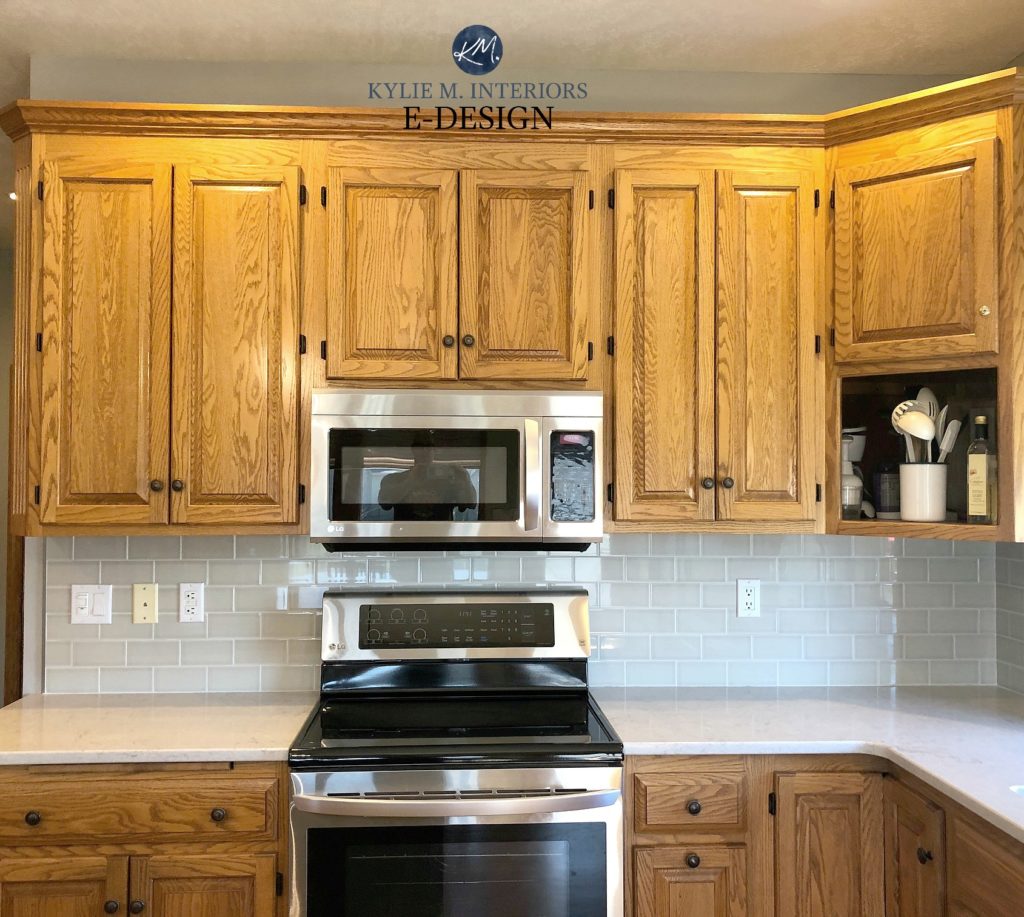Understanding Honey Oak Cabinets and Staining

Honey oak cabinets have been a popular choice for homeowners for decades due to their warm, inviting appearance and durability. However, as design trends evolve, some homeowners may find that the traditional honey oak color scheme no longer complements their desired aesthetic. This can lead to a desire to lighten the cabinets, refreshing the kitchen or bathroom and bringing a more modern look to the space.
Honey Oak Cabinet Characteristics
Honey oak cabinets are characterized by their distinctive warm brown color with a reddish undertone, often described as a “golden” or “honey” hue. The wood grain pattern is typically pronounced, featuring a prominent grain with a distinctive figure. This combination of color and grain pattern contributes to the warm and inviting ambiance associated with honey oak cabinets.
Reasons for Lightening Honey Oak Cabinets, Staining honey oak cabinets lighter
Homeowners may opt to lighten honey oak cabinets for a variety of reasons:
- Modernizing the Space: As design trends shift towards lighter, brighter color palettes, honey oak cabinets can appear dated. Lightening the cabinets can create a more modern and contemporary look, bringing the space in line with current design preferences.
- Creating a Brighter Atmosphere: Darker cabinets can make a room feel smaller and more enclosed. Lightening the cabinets can help to brighten the space, making it feel more airy and open.
- Complementing Other Design Elements: Lightening honey oak cabinets can help to create a more cohesive look by better complementing other design elements in the room, such as countertops, backsplashes, and wall colors.
Staining Techniques for Lightening Honey Oak Cabinets
Lightening honey oak cabinets involves applying a stain that will alter the existing color, creating a lighter hue. There are several techniques that can be employed, each with its own characteristics and advantages:
- Using a Light Stain: This involves applying a stain that is lighter than the existing honey oak color. This technique can effectively lighten the cabinets while still retaining a warm, natural wood tone.
- Using a Whitewash Stain: Whitewash stains are specifically designed to create a light, airy, and slightly distressed look. They often contain a blend of white pigment and a transparent stain, allowing the natural wood grain to show through.
- Using a Color Wash Stain: Color wash stains are similar to whitewash stains but incorporate a variety of colors, including gray, blue, or green, to create a more subtle and nuanced look.
Preparation and Staining Techniques: Staining Honey Oak Cabinets Lighter

Before applying stain, proper preparation is crucial for achieving a successful and even finish on honey oak cabinets. This involves a series of steps that ensure the wood surface is clean, smooth, and ready to absorb the stain evenly.
Cleaning
Thoroughly cleaning the cabinets is the first step. This removes dirt, dust, grease, and any existing finishes that could interfere with the stain’s adhesion.
- Use a mild detergent and warm water to wash the cabinets. A soft cloth or sponge is recommended for cleaning.
- Rinse the cabinets thoroughly with clean water to remove any soap residue.
- Allow the cabinets to dry completely before proceeding to the next step.
Sanding
Sanding is essential for smoothing the wood surface and creating a uniform texture for the stain to adhere to.
- Start with a coarse-grit sandpaper (80-100 grit) to remove any imperfections, scratches, or old finishes.
- Progress to finer grits (120, 150, 180) to achieve a smoother surface.
- Sand in the direction of the wood grain to avoid creating scratches that will be visible after staining.
- Remove all sanding dust with a tack cloth or a damp cloth before proceeding to the next step.
Priming
Priming is optional but highly recommended for honey oak cabinets, especially when using a lighter stain.
- A primer helps to seal the wood pores and create a more even surface for the stain to adhere to.
- It can also help to prevent the wood from absorbing too much stain, resulting in a more consistent color.
- Use a primer specifically designed for wood and allow it to dry completely before applying the stain.
Types of Wood Stains
Various wood stains can be used to lighten honey oak cabinets, each offering different effects and finishes.
- Water-based stains are easy to apply and clean up. They tend to dry quickly and offer good penetration into the wood.
- Oil-based stains provide a richer color and deeper penetration into the wood. They dry slower than water-based stains and require mineral spirits for cleanup.
- Gel stains are thicker than water-based or oil-based stains and are ideal for achieving a more even finish on porous woods like oak. They tend to dry slower and offer good color saturation.
Applying Stain
Applying the stain requires a methodical approach to achieve a consistent and even finish.
- Use a clean cloth, brush, or foam applicator to apply the stain.
- Work in small sections, applying the stain evenly in the direction of the wood grain.
- Avoid over-applying the stain, as this can lead to uneven color and blotchiness.
- Wipe off any excess stain with a clean cloth after the recommended drying time.
- Allow the stain to dry completely before applying a topcoat, such as polyurethane or varnish.
Finishing and Maintenance

After staining, the next step is to apply a finish that will protect the wood and enhance its beauty. This is an essential step that will preserve the color and durability of your cabinets.
Types of Finishes
Finishes provide a protective layer over the stain, shielding the wood from scratches, spills, and other damage. They also enhance the appearance by adding depth and shine. Here are some common types of finishes:
- Polyurethane: A durable and long-lasting finish that offers excellent protection against wear and tear. It comes in both oil-based and water-based formulations. Oil-based polyurethane is known for its durability and depth of finish, while water-based polyurethane is faster drying and easier to clean up.
- Wax: A natural finish that provides a soft, warm sheen and enhances the wood’s natural grain. Wax is less durable than polyurethane but offers a more natural look and feel. It can be applied in layers to build up protection.
- Lacquer: A fast-drying, durable finish that provides a hard, glossy surface. It is often used for furniture and other high-traffic areas. Lacquer can be sprayed or brushed on, and it is available in a variety of finishes, from high gloss to matte.
- Varnish: Similar to lacquer, varnish is a durable finish that protects wood from scratches, spills, and moisture. It is available in a variety of finishes, including gloss, satin, and semi-gloss.
The best finish for your cabinets depends on your desired level of protection, the desired look, and the amount of time and effort you are willing to invest. For honey oak cabinets, polyurethane or wax are common choices.
Maintenance
Proper maintenance is crucial to keep your stained honey oak cabinets looking their best. Here are some key tips:
- Regular Cleaning: Dust your cabinets regularly using a soft cloth or duster. For spills and messes, use a mild soap and water solution. Avoid harsh cleaners or abrasives, as they can damage the finish.
- Touch-Up: Over time, the finish on your cabinets may show signs of wear and tear. Use a touch-up pen or marker to repair minor scratches or chips. For larger areas, you may need to apply a fresh coat of finish.
- Re-waxing: If you have waxed your cabinets, re-waxing them periodically will help maintain their protection and shine. Apply a thin layer of wax and buff it to a smooth finish.
Staining honey oak cabinets lighter can completely transform a kitchen, but it’s important to choose the right color and technique. A lighter shade can make the space feel larger and brighter, and it can also help to create a more modern aesthetic.
If you’re looking for a way to add a touch of visual interest to your kitchen, consider incorporating a vertical shiplap accent wall bedroom behind the cabinets. This will create a dramatic focal point that will complement the lighter cabinets perfectly.
Just be sure to choose a shiplap color that will work well with the new cabinet stain.
Staining honey oak cabinets lighter can dramatically change the feel of a room, creating a brighter and more modern aesthetic. If you’re considering this update, you might also be thinking about moving to a new space, and perhaps a 1 bedroom apartment in Bozeman would be a perfect fit.
After all, a fresh start with lighter cabinets might just be the inspiration you need for a new chapter in your life.